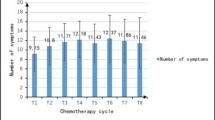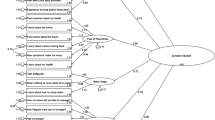Abstract
Purpose: To evaluate scalability of a symptom scale administered to women enrolled in the Breast Cancer Prevention Trial (BCPT) (P-1) conducted by the National Surgical Adjuvant Breast and Bowel Project (NSABP).Patients and methods: Responses of 11,064 women recruited into a study of 20 mg daily tamoxifen versus placebo to prevent breast cancer in high-risk women were analyzed. Exploratory factor analyses of the 12 month data were conducted on a random subset of 4,000 women to estimate the factor structure. Baseline data on these same 4,000 women were analyzed to confirm the structure. The remaining sample was divided randomly into two data sets. Data on each set were then grouped by age (35–49, 50–59, or ≥60 years) and treatment (tamoxifen or placebo) to corroborate these analyses. Correlations between the obtained symptom clusters and two standard instruments (SF-36 and CES-D) were examined. Content analysis of open-ended responses was also conducted.Results: Eight clinically-interpretable clusters of symptoms were identified and confirmed: Cognitive symptoms, musculoskeletal pain, vasomotor symptoms, nausea, sexual problems, bladder problems, body image, and vaginal symptoms. Scoring for each scale represented by these eight clusters is provided. Content analysis of open-ended responses suggested four items that are additional candidates: fatigue, back problems, abdominal pain, and leg/foot cramps or pain. Conclusions: Symptoms associated with hormone therapy for breast cancer can vary. Nevertheless, the BCPT Eight Symptom Scale (BESS) can be clustered into clinically relevant and reproducible factors that may be useful in future outcomes research.

Similar content being viewed by others
References
Jemal A, Tiwari RC, Murray T, Ghafoor A, Samuels A, Ward E, Feuer E J, Thun M J (2004) Cancer statistics. CA Cancer J Clin 54:8–29
Fisher B, Costantino JP, Wickerham DL, Redmond CK, Kavanah M, Cronin WM, Vogel V, Robidoux A, Dimitrov N, Atkins J, Wieand S, Tan-Chiu E, Ford L, Wolmark N (1998) Tamoxifen for prevention of breast cancer: report of the National Surgical Adjuvant Breast and Bowel Project P-1 Study. J Natl Cancer Inst 90:1371–1388
Ganz PA, Day R, Ware JE Jr, Redmond C, Fisher B (1995) Base-line quality-of-life assessment in the National Surgical Adjuvant Breast and Bowel Project Breast Cancer Prevention Trial. J Natl Cancer Inst 87:1372–1382
Gallicchio L, Lord G, Tkaczuk K, Danton M, Lewis LM, Lim CK, Flaws JA (2004) Association of tamoxifen (TAM) and TAM metabolite concentrations with self-reported side effects of TAM in women with breast cancer. Breast Cancer Res Treat 85:89–97
Yen TW, Hunt KK, Mirza NQ, Thomas ES, Singletary SE, Babiera GV, Meric-Bernstam F, Buchholz TA, Feig BW, Ross MI, Ames FC, Theriault RL, Kuerer HM (2004) Physician recommendations regarding tamoxifen and patient utilization of tamoxifen after surgery for ductal carcinoma in situ. Cancer 100:942–949
Greendale GA, Sowers M (1997) The menopause transition. Endocrinol Metab Clin North Am 26:261–277
Fallowfield L, Fleissig A, Edwards R, West A, Powles TJ, Howell A, Cuzick J (2001) Tamoxifen for the prevention of breast cancer: psychosocial impact on women participating in two randomized controlled trials. J Clin Oncol 19:1885–1892
Greendale GA, Reboussin BA, Hogan P, Barnabei VM, Shumaker S, Johnson S, Barrett-Connor E (1998) Symptom relief and side effects of postmenopausal hormones: results from the Postmenopausal Estrogen/Progestin Interventions Trial. Obstet Gynecol 92:982–988
Day R, Ganz PA, Costantino JP, Cronin WM, Wickerham DL, Fisher B (1999) Health-related quality of life and tamoxifen in breast cancer prevention: a report from the National Surgical Adjuvant Breast and Bowel Project P-1 study. J Clin Oncol 17:2659–2669
Day R (2001) Quality of life and tamoxifen in a breast cancer prevention trial: a summary of findings from the NSABP P-1 study. Ann N Y Acad Sci 949:143–150
Ware JE Jr, Kosinski M, Keller SD (1994) SF-36 physical and mental summary scales: a user’s manual. The Health Institute, New England Medical Center: Boston
Stewart AL, Ware JE (1992) Measuring Functioning and Well-Being: The Medical Outcomes Study Approach. Duke University Press, Durham
Radloff LS (1977) The CES-D Scale: A self-report depression scale for research in the general population. Appl Psychol Meas 1:385–401
Harman HH (1976) Modern Factor Analysis. University of Chicago Press, Chicago. 3rd ed
Hotelling H (1933) Analysis of a complex of statistical variables into principal components. J Educ Psychol 24:417–441
Spearman CH (1904) General intelligence objectively determined and measured. Am J Psychol 15:201–293
Cattell RB (1966) The scree test for the number of factors. Multivariate Behav Res 1:245–276
Kaiser HF (1958) The varimax criterion for analytic rotation in factor analysis. Psychometrika 23:187–200
Marsh HW, Balla JR, McDonald RP (1988) Goodness-of-fit indexes in confirmatory factor analysis: The effect of sample size. Psychol Bull 103:391–410
Hatcher L (1994) A Step-by-step Approach to Using the SAS System for Factor Analysis and Structural Equation Modeling. SAS Institute, Inc., Cary, NC, SAS Institute
International resource center for health care assessment (1991) How to Score the SF-36 Health Status Survey. New England Medical Center, Boston
Land SR, Ganz PA (2003) Quality of life issues with endocrine chemoprevention. In: Morrow M, Jordan VC (eds). Managing Breast Cancer Risk. BC Decker, Hamilton, Ontario, Canada
Stanton AL, Bernaards CA, Ganz PA (2005) The BCPT symptom scales: a measure of physical symptoms for women diagnosed with or at risk for breast cancer. J Natl Cancer Inst 97:448–456
Alfano CM, McGregor BA, Kuniyuki A, Reeve BB, Bowen DJ, Baumgartner KB, Bernstein L, Ballard-Barbash R, Malone KE, Ganz PA, McTiernan A (2006) Psychometric properties of a tool for measuring hormone-related symptoms in breast cancer survivors. Psychooncology 15:985–1000
Land SR, Wickerham DL, Costantino JP, Ritter MW, Vogel VG, Lee M, Pajon ER, Wade JL III, Dakhil S, Lockhart JB Jr, Wolmark N, Ganz PA (2006) Patient-reported symptoms and quality of life during treatment with tamoxifen or raloxifene for breast cancer prevention: the NSABP Study of Tamoxifen and Raloxifene (STAR) P-2 trial. JAMA 295:2742–2751
Acknowledgements
Supported by Public Health Service grants U10CA-37377, and U10CA-69974 from the National Cancer Institute, Department of Health and Human Services.
The authors thank Barbara C. Good, PhD, Director of Scientific Publications for the NSABP, and Wendy L. Rea, for editorial assistance.
Author information
Authors and Affiliations
Corresponding author
Additional information
Trial registration: Cancer.gov URL for BCPT/P-1: http://www.cancer.gov/search/ResultsClinicalTrialsAdvanced.aspx?protocolsearchid = 3071847
Rights and permissions
About this article
Cite this article
Cella, D., Land, S.R., Chang, CH. et al. Symptom measurement in the Breast Cancer Prevention Trial (BCPT) (P-1): psychometric properties of a new measure of symptoms for midlife women. Breast Cancer Res Treat 109, 515–526 (2008). https://doi.org/10.1007/s10549-007-9682-9
Received:
Accepted:
Published:
Issue Date:
DOI: https://doi.org/10.1007/s10549-007-9682-9




